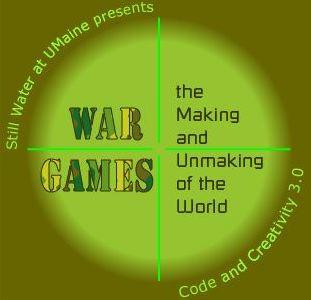

stillwater
for network art and culture
presents
Code & Creativity v3.0
Games: Making and Unmaking the World
Sept 17-24, UMaine New Media
In The Body in Pain, Elaine Scarry equates war/torture/injuring
the body with unmaking the
world; and creative acts including art-making, object-design and religion-building
as making the world.
This conference tackles the tension at the heart of war/gaming and explores
alternative design strategies in the company of some of the top game design
artists working today.
This series of discussions and workshops will explore the increasing prevalence
of electronic war and conflict simulation in military and entertainment contexts
-- raising issues about the construction of gender in the context of gameplay
and game narrative, and also provoking some discussion on issues related to
the upcoming election.
 Fri Sept 17, Mon Sept 20, Wed Sept 22
Fri Sept 17, Mon Sept 20, Wed Sept 22
Presentation of Independent Game Designs
New Media 100, 10 am DPC 115
Prof. Joline Blais
Prof Blais will be previewing works by visiting artists, including Sheik Attack,
Vietnam
Romance, AgoraXchange, The Great Game, Waco Resurrection, Velvet Strike,
O.U.T., Rethinking Wargames, and 3 player chess
Thurs, Sept 23
9:30-11 am
"DeepPlay Seminar"
Collaborative Media Lab, Fogler Library
Game designers discuss their work in the context of "DeepPlay",
ie play that jolts the player out of the trance of gameplay and into moments
of realization and reflection.
12-2 pm
Hands-on Workshop
"Unmaking the world: war games & resistance"
Coe Room, Union
Join game designers Natalie Bookchin, Ruth Catlow, and John Klima as they
demo their twists on the war game genre.
2-3:30
Alan Brinkley
"Civil Liberties After 9/11: Lessons From Past Assaults on Freedoms"
Minsky Hall
Attend this related event sponsored by the Margaret Chase Smith Center.
More info...
4:30-5:30
"Alternative Chess"
Coe Room, Union
Join Ruth Catlow and colleagues for a demonstration of 3 player chess and
other variants on this ancient game of war.
Fri, Sept 24
10-11 am
RPG Roundtable
New Media 100, 10 am
DPC 107
12-2 pm
Hands-on Workshop
Making the world: pushing limits of play
Coe Room, Union
Join game designers Mary Flanagan, Alex Galloway, and Anne Marie Schleiner
as they demo their strategies for pushing the limits of play.
2-3 pm
Myths of Renewal
Coe Room, Union
PArticiapte in an open discussion about linking indigenous legends to visions
of the future, featuring Natalie Bookchin's agoraXchange, and Roberto
Mendoza's take on The Eagle & The Condor (runs concurrent with
Generation Emulaton)
2-3 pm
Generation Emulation
Coe Room, Union
Join Mary Flanagan and Alex Galloway as they discuss emulation's role in game
preservation in the context of the variable media paradigm.
(runs concurrent with Myths of Renewal)
Top game design artists who will be presenting their twists on the tension
between
making and unmaking
the world, include:
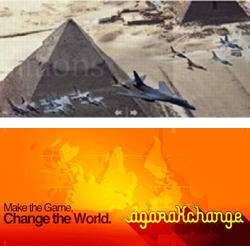
Natalie Bookchin is an artist who has been working on online projects since 1997. She is currently working with political theorist Jackie Stevens on agoraXchange, an online collaboration for imagining and building a massive multiplayer online game that offers a tangible political alternative to our current world order. The first version of the site was commissioned by the Tate Online, and launched in March 2004. She has recently received a Rockefeller Foundation Fellowship to continue developing the project.
Her last project, Metapet (2003) was an online game commissioned by Creative Time, a public arts presenter in New York City, in association with HAMACA, a net art platform in Barcelona made up of six local art institutions and museums. The beta version of Metapet was launched at the Museum of Contemporary Art in Los Angeles; Version 1 was launched on May Day, 2003 and linked from the Whitney Museum’s online gallery.
In 1999-2000 Bookchin organized <net.net.net>, an eight month series of lectures and workshops on art, activism and the Internet at Cal Arts, MOCA in LA, and Laboratorio Cinematek in Tijuana. From 1998 to 2000 she was a member of the collective ®TMark. She was a 2001-2002 Guggenheim Fellow.
Her work is exhibited at institutions including PS1, Mass MOCA, the Museum
of Contemp-
orary Art in Barcelona, KunstWerke, Berlin, the Generali Foundation,
Vienna, the Walker
Art Center, the Whitney Museum of American Art, and the
Shedhale in Zurich. She is
based in Los Angeles and is co-Director of the
the Photography and Media Program in the
Art School at CalArts.
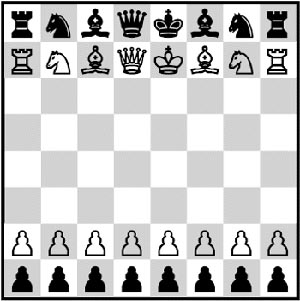
Ruth Catlow's work usually connects with specific groups of people in a distinct condition or environment or they intersect with dominant and pre-established entertainment genres in the mass media such as games or pornography on the web. She works with the big human subjects of love, sex, community, responsibility and freedom. Ruth is an artist, co-founder and director of furtherfield.org (with Marc Garrett).
She works with people, digital and network media, sculpture and drawing;
in the streets & other public spaces and connects to the global digital community
via the Internet. Ruth is currently Associate Senior lecturer in Digital Media
at Ravensbourne College of Design and Communication, UK.
Individual works:
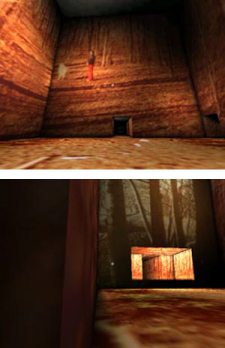
Mary Flanagan's software art has been shown internationally including Whitney Biennial (2002), the Guggenheim Museum (2004), SIGGRAPH, and Ars Electronica. She has published many articles about computer gaming culture in books and academic journals.
Books include Reload: Rethinking Women + Cyberculture (MIT Press 2002), The Sims: Similarities, Symbols & Simulacra (2003) with Matteo Bittanti (in Italian), and Reskin (forthcoming 2005). She is the creator of "The Adventures of Josie True," the first net-based adventure game for girls, and is co-director for Rapunsel, a research project to teach girls programming.
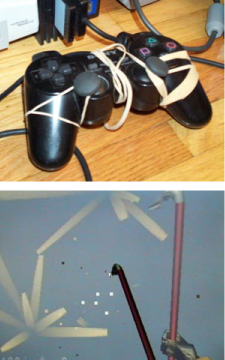
Alexander Galloway is Assistant Professor of Media Ecology at New York University.Ý For six years, Galloway worked as Director of Content and Technology at Rhizome.org.Ý He is a founding member of the software development group RSG whose data surveillance system, Carnivore, was awarded a Golden Nica in the 2002 Prix Art Electronica.Ý
The New York Times recently described his work as "conceptually sharp, visually compelling and completely attuned to the political moment." His first book, published this year by MIT Press is entitled, PROTOCOL: How Control Exists After Decentralization.
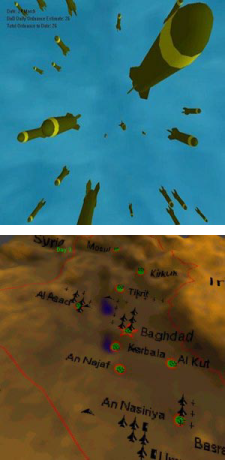
John Klima is an artist and computer programmer whose work explores the creative potential of interactive 3D graphics to create real-time interactive visual and auditory environments.
He has worked with companies such as Microsoft, Turner Broadcasting, and Dun & Bradstreet as well as traditional art venues, including exhibitions in New York at the Whitney Museum and Postmasters Gallery as well as at exhibitions and festivals in Europe and Japan.
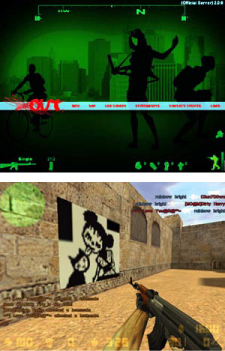
Anne-Marie Schleiner is engaged in gaming and net culture in a variety of roles as an artist, writer, critic, curator, and gaming designer. Her work investigates avatar gender construction, computer gaming culture, and hacker art.
She has curated online exhibits of game mods and add-ons including the exhibits "Cracking the Maze: Game Patches and Plug-ins as Hacker Art", "Mutation.fem", and "Snow Blossom House." She runs a site focused on game hacks and open source digital art forms called "opensorcery.net".
related work
alternative games:
articles:
Related events
connections
articles:
"We all live in our Fantasy and only endure our Reality" - R.A.Wilson
Why Games?
Why do we play & enjoy war games?

Balinese Cockfight
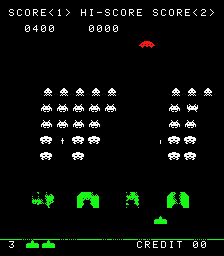
What is realism in war/games?
Some facts to consider:
Why does the U.S. military use simulation games?


Let's look at some footage from a few war/games:
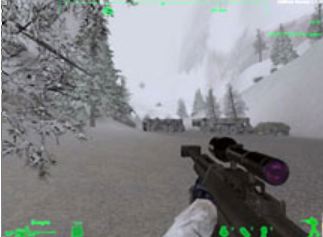
America's Army
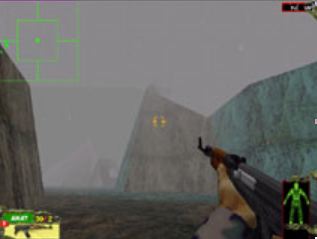
Special Force

Under Ash
Realism , a definition:
America's Army vs Under Ash- realism?
Apache Helicopter gunship in Iraq, may 2004; reported by French tv from actual footage taken in helicopter.
Missed by most US media, brief showing on ABC & CNN, lots of coverage
outside U.S.
online
source for comments & video
Some random comments from above site:
Rewriting the script of war games:
machinima—movies produced using footage from actual game play
Red vs. Blue, Why
Are We Here?
a critical and humorous take on Halo & war games in general
other Halo machinima here
Assignment:
(due mon)
Related resources:
No Quarter: demilitarizing the Playground
What ya need is what they sellin'
Make you think that buyin' is rebellin'
From the theaters to malls on every shore
Tha thin line between entertainment and war
-"No Shelter," by rebel rap/rockers Rage Against the Machine
what is realism after sept 11th?
what is the truth?
the military-industrial-entertainment-complex:
"In his famed 1961 farewell address, President Dwight D. Eisenhower warned
of a dangerous intertwining of private corporations, the armed forces, and
the federal government for which he coined the term "the military-industrial
complex."
By then, the Pentagon had long been exercising script control over most war
films made in Hollywood and the CIA was running covert operations in Vietnam
through a front program at Michigan State University, but Ike wasn't focused
on minor supporting players like the entertainment industry or academia.
In the intervening decades, however, both have grown ever more central to
the Pentagon's mission. No longer is the Ivory Tower's participation limited
to advisory programs and research for future weapons systems or Hollywood's
contribution a series of Why We Fight propaganda films or triumphalist John
Wayne flicks." —Nick Turse Bringing
the War Home
one example of disputed news item:
what really happened at the pentagon?
9/11 Pentagon Strike: who 's striking whom?
Realism in war games:
1-under ash
the restricted code of Palestinian resistance and homeland defense
( text from game website):
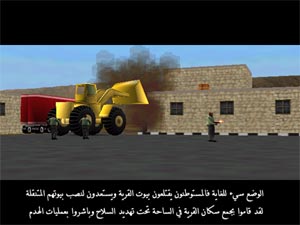 "A
nation in Palestine is being uprooted: their houses are being devastated,
their establishments are being destroyed, their lands are being occupied,
their trees are being pulled out, their property is being confiscated, their
cities are being besieged, their schools are being closed, their sanctuaries
are being violated, their sacred structures are being made permitted, their
children are being beaten, their hands are being broken, their bones are being
crushed and they are imprisoned, tortured and slain.
"A
nation in Palestine is being uprooted: their houses are being devastated,
their establishments are being destroyed, their lands are being occupied,
their trees are being pulled out, their property is being confiscated, their
cities are being besieged, their schools are being closed, their sanctuaries
are being violated, their sacred structures are being made permitted, their
children are being beaten, their hands are being broken, their bones are being
crushed and they are imprisoned, tortured and slain.
They are even prevented from crying and moaning. The whole
world is plotting to ignore them. None hears them moan. None sees the trains
of their martyrs. None says a word of support to their rights.
The human conscience, [will not be] deceived by...the violence of the tyrannical
aggression and the violence of resistance in self-defense, nor will the destructive
rocket be equal to the symbolic stone.
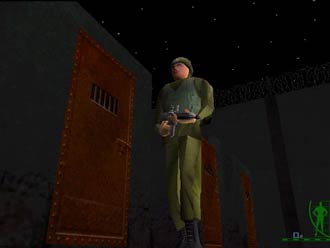 Under
Ash is a call to justice, realizing truth, preventing wronging and aggression.
Under
Ash is a call to justice, realizing truth, preventing wronging and aggression.
This idea, accompanied by the best available technology, is still handy to
our youth, trying to dry up their tears; heal their wounds; remove all the
feelings of humiliation, humbleness and wretchedness from their souls, and
draw the smile of hope and the sense of dignity and efficiency on their faces."
"Under Ash, from Damascus, depicts the plight of a young Palestinian man during the intifada. The game turns the tables on Israeli occupation, letting the gamer fight back, as it were, first with stones, then with guns. The game is not fantasy escapism, though, but instead takes on an almost documentary quality, depicting current scenarios in the occupied territories such as the demolishing of Palestinian houses. Combat is central to the narrative but slaying of civilians is penalized. In addition, the game is distinctly difficult to play, a sardonic instance of socio-political realism in a land fraught with bloodletting on both sides.
Under Ash takes a more sober, almost educational tone. The game’s
designers describe Under Ash as acting in opposition to what they call “American
style” power and violence.
Under Ash players, then, have a personal investment in the struggle depicted
in the game, just as they have a personal investment in the struggle happening
each day around them. This is something rarely seen in the consumer gaming
market. The game does nothing to critique the formal qualities of the genre,
however. Instead it is a cookie-cutter repurposing of an American-style shooter
for the ideological needs of the Palestinian situation. The engine is the
same, but the narrative is different. "
-Alex Galloway
2-america's army
the "universal code' of American fear and desire for global dominance

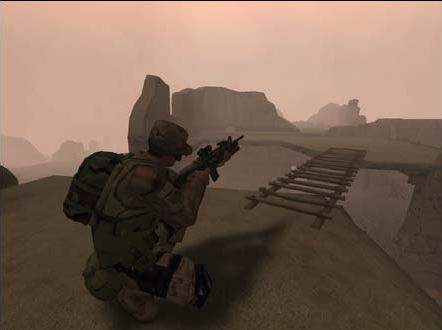
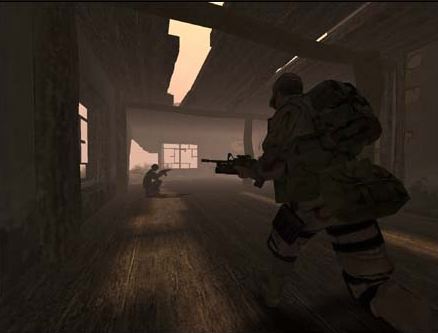
..."Contrasted with these Palestinian games, America’s Army
does in fact achieve a sort of sinister realism, for it can’t help but
foreground its own social ideology. It is not a subjugated ideology, but it
is indeed an expression of political realities as they exist today in global
military power struggles.
Statistics on public opinion illustrate that the average American
teenager playing America’s Army quite possibly does harbor
a strong nationalistic perspective on world events (even though he may be
leery of actual war, and might never fight in America’s real army).
The game articulates this perspective.
Again, this is not true realism, but, like it or not, it is a real articulation
of the political advantage felt by and desired by the majority of Americans.
It takes a game like Special Force, with all of Hizbullah’s
terror in the background, to see the stark, gruesome reality of America’s
Army in the foreground.
3-Toys too...
Gruesome "Talking
Dual-headed Uday", Saddam's son
From Vicale Corporation
4-Eddo Stern's Sheik
Attack
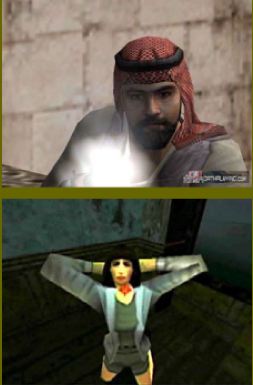
machinama from selcted compuer games, & traditional folk songs
"a contemporary non/fiction horror film woven from pop
nostalgia, computer war games, the sweat of virtual commandos, the blood of
Sheiks and a mis-remembrance of a long lost Zionist Utopia" Eddo Stern
If you will practice being fictional for a while, you will understand that
fictional creatures are sometimes more real than people with bodies and heartbeats
—Richard Bach, "Illusions"
Who are we really fighting?
1-Grand Theft Auto: Vice City
"In Grand Theft Auto 3, [you] must work your way back up the crime
ladder by completing missions—killing rivals, stealing cars, delivering
packages. If you survive and evade enemies and arrest, you may regain some
of your lost power in Liberty City, “the worst place in America”.
Liberty City is a fully rendered, fully destructible city. You can leave skid
marks on the pavement, dents in your car, blood and mashed bodies on the sidewalk.
And apart from competition from rivals or tracking by police, you are lord
over this environment with nine lives to use up, and millions to make. Even
arrest for multiple felonies, and a string of murders gets you only a mild
slap on the wrist by the ineffectual criminal justice system: you lose weapons
and points and end up right back on the street.
...substitute “corporate ladder” for “crime ladder”
and you get a shocking but revealing portrait of the typical American city:
corporate bosses competing for “blood money” in such a way that
endangers human lives, an ineffectual criminal justice system, citizen with
pent-up rage, and enough jazzy cars, missions and music to keep us all playing
the game. Liberty City, “the worst place in America” might easily
represent an America ruled by corporate and government bosses. (military-industrial-entertainment
complex?)"--DeepPlay, Blais & Ippolito
2-Turning the Tables: State of Emergency
 "State
of Emergency, the riot game from Rockstar Games, has some of these protorealist
qualities. The game coopts the spirit of violent social upheaval, seen in
events like the Rodney King rebellion in L.A., and transposes it into a participatory
gaming environment. The game is rife with absurdities and excesses and in
no way accurately depicts the brutal realities of urban violence. So in that
sense it fails miserably at realism--something like a NARC for the new millennium.
"State
of Emergency, the riot game from Rockstar Games, has some of these protorealist
qualities. The game coopts the spirit of violent social upheaval, seen in
events like the Rodney King rebellion in L.A., and transposes it into a participatory
gaming environment. The game is rife with absurdities and excesses and in
no way accurately depicts the brutal realities of urban violence. So in that
sense it fails miserably at realism--something like a NARC for the new millennium.
But it also retains a realist core. While the game is more or less realistically
rendered, its connection to realism is seen primarily in the representation
of marginalized communities (disenfranchised youth, hackers, ethnic minorities,
and so on), but also in the narrative itself, a fantasy of unbridled, orgiastic
anti-corporate rebellion. The game slices easily through the apathy found
in much mass media today, instructing players to “smash the corporation”
and then giving them the weapons to do so. " Alex Galloway
3-Smashing the real corporation: Toywars

"The Toywar battlefield, which was online for only a few months, is
a complex, self-contained system, with its own internal email, its own monetary
system, its own social actors, geography, hazards, heroes and martyrs. Players
were able to launch “media bombs” and other public-relations stunts
aimed at increasing public dissatisfaction toward eToys.com’s lawsuit.
In the first two weeks of Toywar, eToys.com's stock price on the NASDAQ plummeted
by over 50% and continued to nosedive. Of course, eToys.com's stock price
was also crashing due to the general decline of the Internet economic bubble,
but this economic fact only accentuated the excitement of gameplay. Eventually
a few billion dollars of the company’s stock value disappeared from
the NASDAQ and the toy retailer declared bankruptcy.
Whereas State of Emergency prodded gamers to smash a hypothetical corporate
thug, Toywar gave them a chance to battle a real one. And this is the crucial
detail that makes Toywar a realist game. For, similar to a simulation or training
game, Toywar constructed a one-to-one relationship between the affective desires
of gamers and the real social contexts in which they live. "-- Alex Galloway
Blurring the boundary 1
newsgaming
news-->game
Kuma
John Kerry & Swift Boat PCF-94
Blurring the boundary 2
re:news
game-->news
Sept
12th
Gonzalo Frasca & newsgaming.com
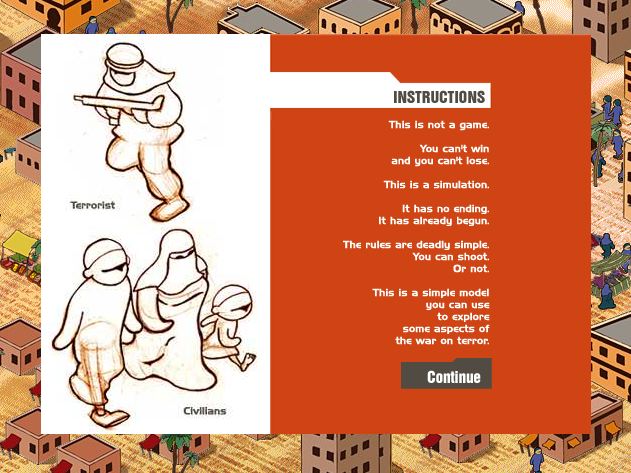
Great Game
John Klima
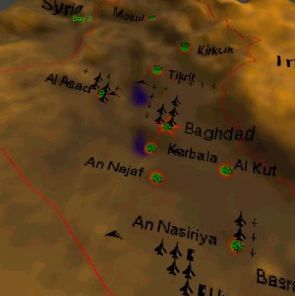
Waco Resurrection
C-level
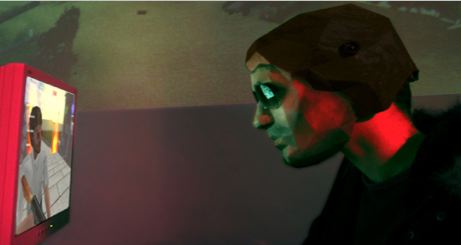
As predicted by his Branch Davidian followers, Vernon Howell (aka David Koresh)
has returned to Mt. Carmel for final battle. Revisiting the 1993 Waco, Texas
episode, gamers enter the mind and form of a resurrected David Koresh through
custom headgear, a voice-activated, hard-plastic 3D skin. Each player enters
the network as a Koresh and must defend the Branch Davidian compound against
internal intrigue, skeptical civilians, rival Koresh and the inexorable advance
of government agents. Ensnared in the custom "Koresh skin", players
are bombarded with a soundstream of government “psy-ops”, FBI
negotiators, the voice of God and the persistent clamor of battle. Players
voice messianic texts drawn from the book of revelation, wield a variety of
weapons from the Mount Carmel cache and influence the behavior of both followers
and opponents by radiating a charismatic aura.
Waco Resurrection re-examines the clash of worldviews inherent in the 1993
conflict by asking players to assume the role of a resurrected "cult"
leader in order to do divine battle against a crusading government. While
the voices of far-off decision-makers seem resolute and determined, the "grunts"
who physically assault the compound appear conflicted and naive in their roles.
The game commemorates the tenth anniversary of the siege at a unique cultural
moment in which holy war has become embedded in official government policy.
In 2003, the spirit of Koresh has become a paradoxical embodiment of the current
political landscape - he is both the besieged religious other and the logical
extension of the neo-conservative millennial vision. Waco is a primal scene
of American fear: the apocalyptic visionary - an American tradition stretching
back to Jonathan Edwards - confronts the heathen "other" - in Waco
Resurrection, the roles are anything but fixed.
The Endgames series incorporates elements of subjective documentary and speculative
fiction with new interactive technologies to create a visceral gaming experience
focused on extreme psycho-social phenomena. The series hopes to present both
player and viewer with immersive apocalyptic experiences that prompt reconsideration
of the phenomenal possibilities inherent in ideological conflict.
Games with visceral consequences
Cockfight Arena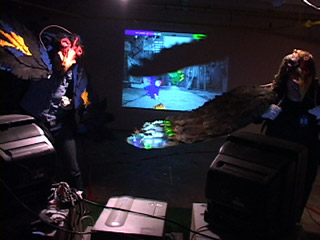
Players and game for C-Level's Cockfight Arena
A one night parade of sweat and adrenaline pitting viewer against viewer in brutal virtual cockfighting theatre. Audience volunteers will don custom-made game controllers with full sized wings and feathered helmets. Combatants will step into an arena to control their life size game avatars through vigorous flapping and pecking, competing for blood and birdfeed while rapaciously inflicting onscreen bodily harm.
Pain Station 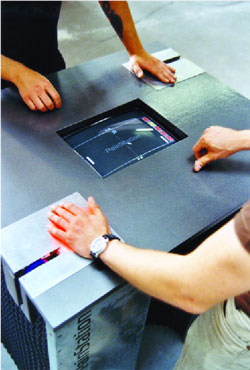
Volker Morawe and Tilman Reiff: PainStation, installation
shot; photo Otto Saxinger;
courtesy Ars Electronica
PainStation by Volker Morawe and Tilman Reiff was a simple but effective concept. A 'Pong'-like game is played by two people standing on either side of a horizontal screen. You play by twiddling a knob with your right hand, while the left is positioned on a sensor field, from which it is subject to an electric shock if the ball misses the bar bat operated by the player, and strikes a particular symbol on the screen. The game is won as soon as one of the players is forced to remove his/her hand. The experience is quite painful as I can attest, having lost to a young female player from Linz. A sign above the table - in German only - warned children and people with pacemakers not to try it. (Would a project like this even get off the ground in Ireland, where lawyers and insurance companies rule unchallenged?)
Invisible Force
Crispin Jones: An Invisible Force, installation shot; photo
Otto Saxinger;
courtesy Ars Electronica
Crispin Jones: An Invisible Force, installation shot;
photo Otto Saxinger; courtesy Ars Electronica
A similar concept operated with Crispin Jones' installation An Invisible Force.
A fortune-telling machine laboriously spells out, through raised squares on
a table, the supposed answer to the inquirer's question, while a plate under
the person's left hand grows progressively hotter. If your curiosity is stronger
than the pain, you have beaten the system. In theoretical terms, the artist
is interested in exploring parallels between computer technology and traditional
divination.
Fish, John Klima



opt o.u.t.
some alternatives to war, heros, and straight play
rethinking wargames
variation on the "game blame same" routine

3 player chess & other alternatives on this classic game
Digital tech changes the world
Any technology tends to create a new human environment. Printing from movable types created a quite unexpected new environment -- it created the public. Manuscript technology did not have the intensity or power of extension necessary to create publics on a national scale.
What we have called "nations" in recent centuries did not, and could not, precede the advent of Gutenberg technology anymore than they can survive the advent of electric circuitry with with its power of totally involving all people in all other people.
We are today [1965] as far into the electric age as the Elizabethans had advanced into the typographical and mechanical age. And we are experiencing the same confusions and indecisions which they had felt when living simultanesouly in two contrasted forms of society and experience. --Marshall McLuhan, 1965 The Gutenberg Galaxy
agoraXchange
Natalie Bookchin

gender strike
Anne Marie Schleiner
Mary Flanagan
Eric Zimmerman
playful hacks
Alex Galloway

prepared playstation & half-like hack
taking control of the code
-some say that computer code will replace legal code as the main organizing mechanism of human society. if so, will microsoft take over, or will hackers and open source programmers lead the democratic revolution?
hundreds of pages of text to show a simple thumb twitching game?
future play